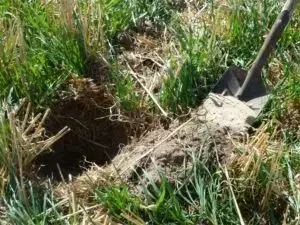‘Prospect Pastoral Company’
Against all odds: Turning Sand into Profit
A REGENERATIVE AGRICULTURE CASE STUDY
 Initially investing in 660 hectares of marginal and degraded wheat country, Ian and Dianne Haggerty have built up a successful production area of 8000 hectares producing cereals and sheep on limited rainfall and sandy salt-affected soils.
Initially investing in 660 hectares of marginal and degraded wheat country, Ian and Dianne Haggerty have built up a successful production area of 8000 hectares producing cereals and sheep on limited rainfall and sandy salt-affected soils.
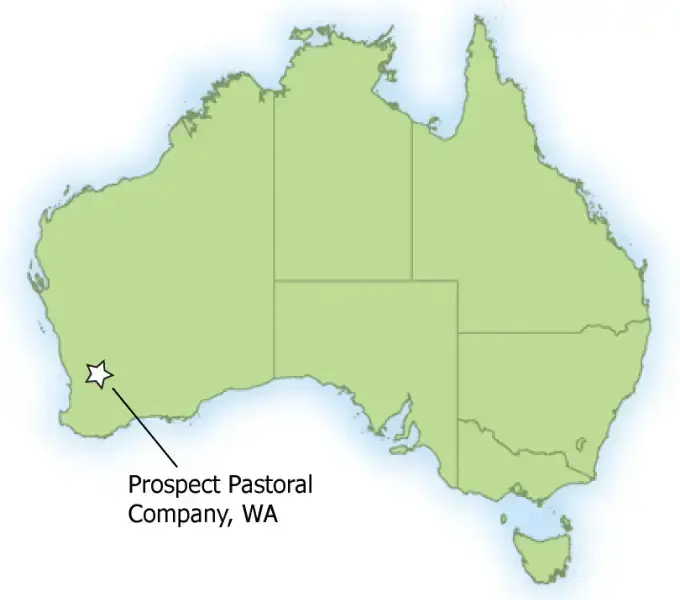
Wyalkatchem, Dowerin, Cunderdin and Meckering districts, around 190 km north east of Perth, WA Central Wheatbelt
ENTERPRISE: Crops. Sheep. Cereal grains and cereal hay crops; specially-bred sheep for wool and premium grade fat lambs
PROPERTY SIZE: 8000 hectares
AVERAGE ANNUAL RAINFALL: 200-300 mm
ELEVATION: 320m (homefarm)
MOTIVATION FOR CHANGE: Reducing rainfall and rising input costs
INNOVATIONS
- Introduction of biological fertilisers and zero tillage to improve soil function and structure
- Integration of grazing with cropping to enhance nutrient cycling and soil structure
- Revegetation to limit spread of salt
- Innovations commenced: 1994
KEY RESULTS
- Successful crop production on 100mm rainfall
- Increased soil water-holding capacity
- Sheep bred to adapt to local environment lambing at 90%-150% and producing high quality 17-20 micron wool
Introduction
Ian and Dianne Haggerty, and their son James, run a holistic and integrated program of cropping and grazing. The program is underpinned by their shared deep commitment to the regeneration of the fertility of the marginal soils of their area. This is achieved through use of biological fertilisers, zero tillage and the consequent growth of healthy cereal plants to deliver high tonnages of premium grain per hectare. The healthy ground cover of the cropping and pasture also provides the key to maintaining high levels of soil moisture and ensuring weed control.
Over the years, Ian and Dianne have developed their own Merino stud and a working sheep flock from local and South Australian bloodlines. This indigenous flock has been bred to be totally acclimatised to the land farmed by the Haggertys.
Their production area is now spread over a number of holdings equalling 8000 hectares of their own property, leased land and share-farming enterprises. This diversity has enabled more effective management across various landscape conditions and rainfall availability.
Settling In
Ian and Dianne came to the original property in Wyalkatchem in 1994 after having run a successful business at Derby in the north west of Western Australia. They had a long shared desire to be farmers and naturally gravitated towards their origins in the Eastern Wheat belt of Western Australia.
The original property purchased by Ian and Dianne lies on undulating semi-arid country to the north of Wyalkatchem WA, bordering on Wallambin Salt Lake. Due to the size and location of the property, farm advisors originally suggested the best alternative was to get out before they got started, however this only challenged the Haggertys to make a good go of things. For the first few years they made a start with the help of machinery from Dianne’s father who owns a neighbouring property.
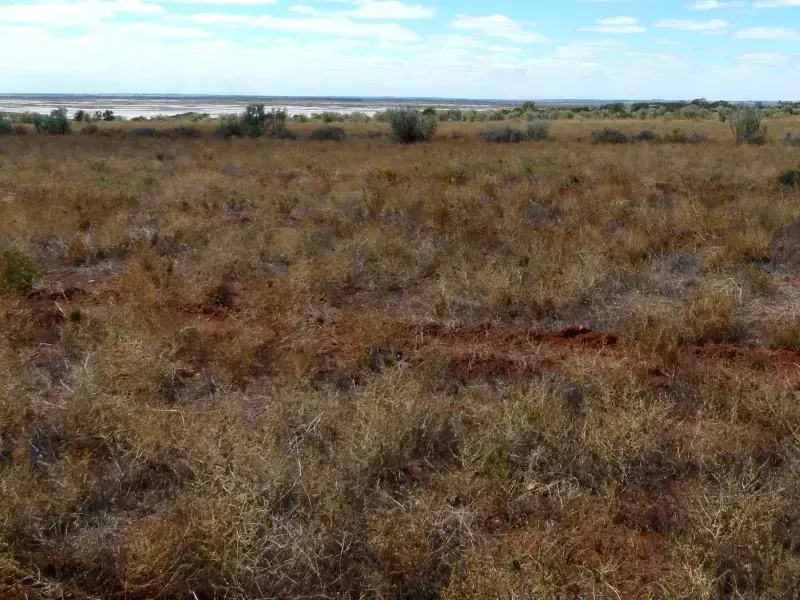
Local landscape with salt lake in the distance.
During the remainder of the 1990s rainfall proved relatively reliable with mostly average rainfall seasons, some excellent seasons and a couple of dry seasons. Following conventional best practise at this time proved profitable and enabled Ian and Dianne to begin acquiring their own machinery.
However, through experiencing the couple of dry seasons, the Haggertys realised the vulnerability of the farming system they were following, as the production decline in these years was significant. Observations of poorly developed root systems and the low resilience of plants to short springs encouraged Ian and Dianne to explore what might be limiting these factors within the soil. This instigated an ongoing pursuit of knowledge regarding soil health and soil productivity.
In addition, rising input costs without a corresponding rise in productivity also provided cause for concern. From this grew a desire to enable the soil to produce an optimum outcome with whatever seasonal conditions unfolded – without expensive inputs.
With the coming of the new decade the rainfall patterns made a determined turn for the worse, with mostly below-average rainfall patterns or significant “dry spells”. This gave the Haggertys a clear indicator that moisture was king, and rainfall preservation and optimal use would be the most powerful profit driver for the enterprise.
Whilst in Derby, Ian and Dianne had made contact with Robyn Tredwell 1, manager of Birdwood Downs Station. It was here that they learnt the principles of using livestock as “weeders, seeders and feeders” in regenerating pastures with appropriate management. This experience was an early trigger for Ian and Dianne to investigate many of nature’s processes; how careful management could enable successful utilisation of nature’s efficiencies at minimal cost. This view was also supported by Dr Elaine Ingham and Dr Arden Andersen with whom the Haggertys commenced their education in biological agriculture. Understanding of livestock management and interaction with the soil environment was further enhanced by learning with Jane Hinge of South Australia.
The original 660 hectare purchase has since been expanded over the years by leasing and share farming enterprises throughout the districts of Wyalkatchem, Dowerin and Meckering. These additional properties are not adjacent, so distance is a constant factor in farming management.
Holistic Management
Each of the properties managed by the Haggertys produce cereal grains (wheat, oats and barley), cereal hay and sheep for wool and meat. The inclusion of leased land and share-farming enterprises in various locations in their operations has given Ian and Dianne the option of cropping and grazing on different soil types and in different rainfall zones. They can also move sheep to optimise feed on offer and water supply and can choose the location and intensity of cropping operations against landscape conditions and rainfall availability from one part of the enterprise to another.
The grazing operations are integral to the whole. The cropping and hay production contribute to our production of premium wool and lamb, but the sheep are playing their part in fertilising the land and working the soil for us.
Ian and Dianne are careful to ensure that each practice that comprises the holistic management of their cropping and grazing operations contributes to the whole. Only the highest quality components underpin the individual and carefully thought out farming practices.
Cropping
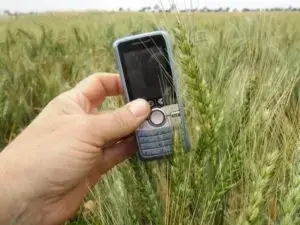
Grain head size is seen as a reliable indicator of soil health.
To grow cereals, Ian and Dianne use a process of no-tillage direct drilling of grain seed, supported by application of biological fertilisers, based on high grade worm liquid and compost extract at a cost of $30 a hectare. Cereal stubble and areas of perennial shrubs – Rhagodia spp., saltbush (Atriplex spp.) and tagasaste (Chamaecytisus palmensis), or tree lucerne, – provide grazing for sheep in summer and autumn. Winter and spring grazing is provided by annual volunteer plants, grasses and legumes.
Enhanced microbial activity in the soil and the use of specially-bred sheep as the ‘farm machinery’ above the surface has lifted the resilience and fertility of the land, improving the soil function, structure and water-holding capacity and continuing to value-add to the productivity of the landscape.
“We truck our worm juice and compost from the Victoria and New South Wales suppliers with a proven record of providing only the highest grade products. The compost extract is produced by our own centrifuge which was sourced from the United States”, Ian notes.
The Haggertys have a preference for older varieties of grain that were in common use before the introduction of farming methods which rely on high levels of chemical intervention. They are constantly on the lookout for additions to their seed bank.
Seeds are microbiologically coated before sowing. Ian has integrated a low pressure liquid fertiliser circuit into their seeder so that the microbiologically coated seed is drilled into a microbial environment stimulated by the liquid fertiliser. This ensures that the plant is supported from germination to early growth.

The seed drill microbiologically coats the seed and applies liquid fertiliser to stimulate growth.
When Ian digs over a shovel full of heavy red soil in the paddock it becomes obvious how each plant growing in it acts as a carbon pump. The plant root growth has broken up sub-surface hard pan in these heavier soils affected by earlier farming methods. By not providing water soluble fertilisers with the seed, extensive root system growth is stimulated and the plant is able to reach wider and more deeply for moisture and nutrition.
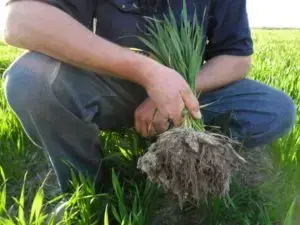
Extensive root growth is a sign of a healthy nutrient system.
Similarly, observation of root growth in the poorer sandy soils in other paddocks being cropped, show the extensive root growth which adds carbon and nutrients to the soils. These roots hold the soils together and spread the microbial environment within the soil.
As Ian describes, “Healthy flourishing plants slow down runoff from the meagre rainfall, that can be as little as 100mm during the growing period, the microbial activity and associated improvement in soil structure maximises the retention of moisture in the soil”.
“Crop quality is checked by periodic testing of tissue nutrient levels and inspection of grain head development during growth. We find this is a more reliable measure of what is available to plants from the soil, rather than testing the soil itself.”
Grazing
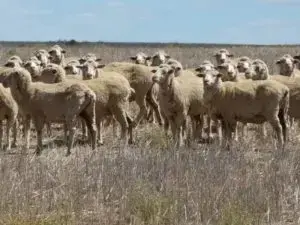
The sheep have been specifically bred to suit the environment.
“Once grain is harvested, the stubble of the crop grown in this high microbial environment provides nutritious grazing fodder for the sheep. In due course, remnant stubble is trampled down and is broken down by fungi to add to the organic carbon in the soil. Together with the dung provided by the sheep and their stimulation of the soil surface by walking on it, the soils become a gift that keeps on giving.”
Ian and Dianne have carefully bred their line of sheep to be adaptive to their local environment. Through a combination of their breeding and grazing practices, including short, controlled periods of grazing in individual paddocks, the sheep are resistant to stomach parasites and do not require drenching. The sheep have been bred for clean legs, faces and crutches; the Haggertys do not practice mulesing but maintain regular crutching.
The sheep thrive on cereal stubble and native shrubs and grasses as their rumen flora is totally adapted to maximising nutrient extraction from roughage. The livestock do not receive any grain supplementation. The sheep are shorn every eight months and produce lambs at a rate between 90 and 150% per annum. As the Haggertys say, “We couldn’t afford to replace our ewes. They have developed into hardy, efficient producers with minimal artificial support highly adapted to our local environment. They could not be replaced easily”.
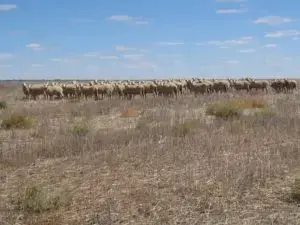
Pregnant ewes amongst wheat stubble.
Alpacas run with each flock of sheep to reduce the threat from foxes.
Dianne points out, “The grazing operations are integral to the whole. The cropping and hay production contribute to our production of premium wool and lamb, but the sheep are playing their part in fertilising the land and working the soil for us”.
The sheep produce high quality 17-20 micron wool (8-9kg average per fleece adjusted for 12 months growth) and premium grade fat lambs. Some of the Haggerty’s stud rams are sold to other farmers looking for robust, economical performance.
The Whole
The Haggertys note, “The spread of our operations throughout the district enables us to maximise the virtues of each piece of land and minimise its shortcomings. We have learnt what each paddock can contribute to our operations season by season and what we need to do for that paddock to ensure the continuation of its productivity”.
None of this would be completely effective without our understanding of the land as a living organism…
“None of this would be completely effective without our understanding of the land as a living organism and our connection to its life cycle. As we contribute to it, we live from it, we live with it – we must understand its nature and its inner life, what it gives to us and what it needs from us to work on our behalf.”

Predicted seasons and conditions are strongly considered when choosing land for cropping. The potential for productivity when biological processes are introduced can be clearly seen on these sandy soils.
With What Water?
The farming operations continue to deliver high quality grains and cereal hay at significant yields even when the rainfall during the growing season has been as low as 100mm. Average annual rainfall has been only 200-300mm since 2000.
Because of the low average rainfall and the predominance of lower rainfall and drought years over higher than average years, Ian and Dianne plan for operations in drier conditions as being the norm. Their cropping strategies and practices emphasise retention of water in the soils through soil quality management and by minimising runoff and evaporation. In this context, they choose cropping land with the best potential for a high yield in the predicted season ahead.
The runoff in all paddocks is so minimal that they do not rely to any great degree on dams for stock water, although at least one dam in one of the cropping/pasture paddocks is fed by ground water. The mainstay of stock watering is water from the wheat belt watering scheme that pipes water from Mundaring Dam.
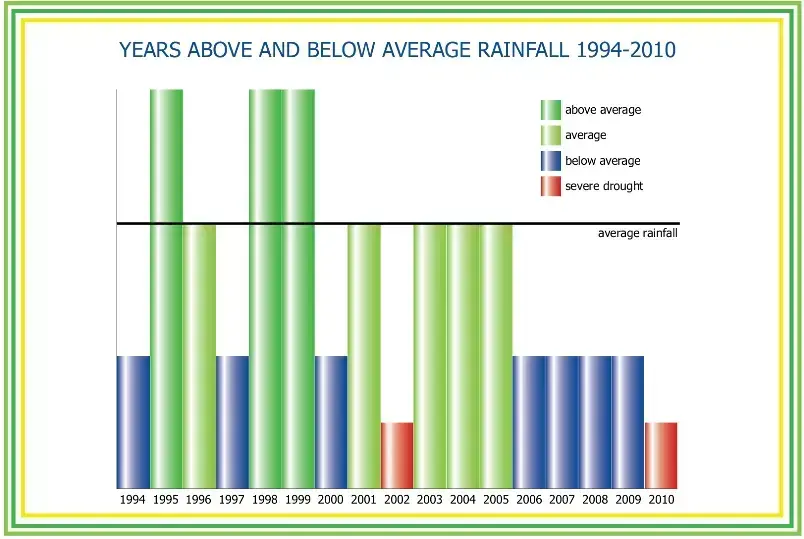
On what Soil?
-

The sandy soil (on spade) is visibly improved with organic matter after only two crops.
breaking through shallow, sub-surface hard pan in heavy soils caused by previous high till, high chemical farming
- breaking up clay mosaics
- opening the soil’s surface to water penetration
- building up soil structure that allows roots to penetrate deeply and widely
- efficient breakdown of stubble and litter by microbes and fungi
- weaning newly acquired land from chemicals while maintaining production
Ian and Dianne are faced with considerable dry land salinity, particularly on land close to Lake Wallambin where salt is picked up by wind and deposited on their land. They have planted lanes of saltbush and acacia in these areas. They use sheep to graze these areas and contribute to soil fertility through dung deposit. In the more saline areas they sometimes put out hay to attract the sheep to these areas and concentrate dung around the feeding point.
Below the surface, the action of microbes, fungi, worms and dung beetles is obvious in any shovel full of paddock soil. Above the surface, trees, shrubs and ground cover sustain other micro bio-diverse environments that support insect life and reptiles, including a few hardy frogs. There are numerous bird species and macro fauna using these areas. This biodiversity can be traced back to the strategies and practices Ian and Dianne have developed under their vision for biological farming.
Vegetation Management
The saltbush lanes help to control the movement of salt from the salt lake. Ian and Dianne have also planted a number of different species of annuals and perennials to help manage the spread of salt. Many failed, and they learned from that experience that the annual pasture legume, yellow serradella, has proven a good survivor. It does well in acidic soils, has deep roots and is a prolific seed producer. Native grasses are returning to cropping paddocks and grow well if there is summer rain. However, the prime source of grazing fodder in summer and autumn is cereal stubble.
Once grain is harvested, the stubble of the crop grown in this high microbial environment provides nutritious grazing fodder for the sheep…
Ian and Dianne are careful not to impact on the residual paddock trees or clumps of bushland. They have also planted salmon gums (Eucalyptus salmonophloia) and other species to foster the growth of stock shelter and wildlife corridors, and to reduce the impact of salt from the nearby Lake Wallambin. Use of a tree planter allows for large numbers of seedlings to be planted quickly. In one location they have fenced off a particularly representative plot of ancient residual Mallee to preserve its integrity.
As they work up and develop the potential of a newly acquired piece of land, Ian and Dianne will immediately use the livestock to begin the process of biologically inoculating soil that may not have had biological activity encouraged for some time. They are quickly able to reduce rates of chemical use by altering the soil surface and not providing the excess nitrogen and phosphorous that weeds seem to thrive on. The main species of weeds are barley grass (Hordeum spp.), annual rye grass (Lolium rigidum) and wild radish (Raphanus raphanistrum). The former respond to herbicides, but, in some cases of heavy radish infestation, which is hard to kill with herbicides, Ian prefers to slash whole paddocks and then turns them over to grazing significantly reducing seed set for the following crop season.
The Team Works
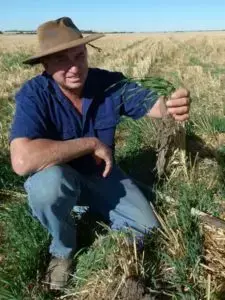
an Haggerty showing the healthy root development of plants grown in sandy soil.
Ian and Dianne are working together in a close partnership, Ian managing cropping and Dianne managing animal production, but working together to integrate both production streams. Eldest son James is also working on the property, having graduated from agricultural college. Other members of their families are located on nearby properties.
Together, the Haggertys are continuing and improving regeneration of farming landscape in every part of the enterprise in terms of both soil fertility and soil water-holding capacity, whilst minimising the impact of ground salinity. Their production is showing a continuing trend to higher yields per millimetre of rainfall and higher quality of cereal grains and cereal hay. The home grown Merino stud and flock ewes acclimatised to the property are producing high grade wool and fat lambs for ‘boutique’ butchers.
Ian and Dianne keep detailed records of inputs to their enterprises and have an encyclopaedic knowledge of the success and failures over the years. They believe that landholders must monitor carefully the transitions in their own land and their financial capacity to enact change. They note that there is always good advice out there somewhere but, even when you find it, external input can only help you so far. Ultimately, the farmer is responsible for their own learning and farm development.
The Haggertys also reinforce that farmers must be prepared to try things that may not necessarily work. Ian and Dianne have been involved in trialling many species of perennial pastures, both grasses and shrubs, to extend the ‘green grazing window’ throughout the prolonged dry summer and autumn period which is typical in Western Australia. To date some introduced species are managing to survive including Rhodes grass (Chloris gayana), Gatton panic (Panicum maximum) and tall wheat grass (Thinopyrum ponticum), however the most reliable performers in dry seasons are the saltbush, Rhagodia, native wattle and tagasaste shrubs. Encouraging the right environment for native perennial grasses to flourish in the event of summer rain is a priority.
The Prospect Pastoral Company is very much a busy family enterprise and a personal priority. Ian and Dianne work closely together to integrate cropping and grazing with the geography of their operation enabling much opportunity along with a large commitment of time to monitor and manage. Nonetheless, they are always willing to share their knowledge and experience with others, attending field days on a wide range of topics and themes and maintaining involvement with the local Landcare group.




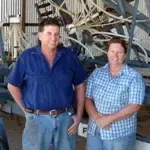 Initially investing in 660 hectares of marginal and degraded wheat country, Ian and Dianne Haggerty have built up a successful production area of 8000 hectares producing cereals and sheep on limited rainfall and sandy salt-affected soils.
Initially investing in 660 hectares of marginal and degraded wheat country, Ian and Dianne Haggerty have built up a successful production area of 8000 hectares producing cereals and sheep on limited rainfall and sandy salt-affected soils.